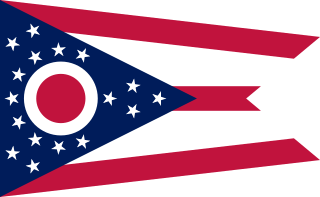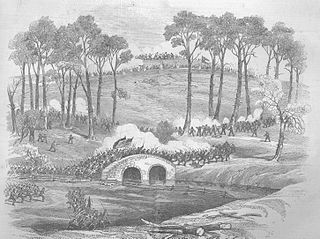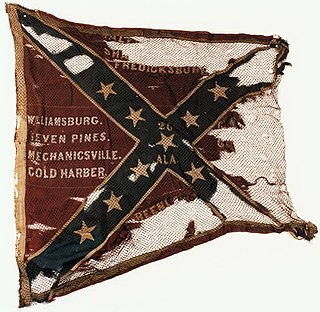
The 20th Maine Infantry Regiment was a volunteer regiment of the United States Army during the American Civil War (1861–1865), most famous for its defense of Little Round Top at the Battle of Gettysburg in Gettysburg, Pennsylvania, July 1–3, 1863. The 133rd Engineer Battalion of the Maine Army National Guard and the United States Army today carries on the lineage and traditions of the 20th Maine.
The First Vermont Brigade, or "Old Brigade" was an infantry brigade in the Union Army of the Potomac during the American Civil War. It suffered the highest casualty count of any brigade in the history of the United States Army, with some 1,172 killed in action.
The 1st North Carolina Regiment of the Continental Army was raised on September 1, 1775, at Wilmington, North Carolina. In January 1776 the organization contained eight companies. Francis Nash was appointed colonel in April 1776. The regiment was present at the defense of Charleston in 1776. It transferred from the Southern Department to George Washington's main army in February of 1777. At that time, Thomas Clark became colonel of the 1st Regiment. The regiment became part of General Francis Nash's North Carolina Brigade in July.
The 8th Ohio Infantry Regiment was an infantry regiment in the Union Army during the American Civil War. It served in the Eastern Theater in a number of campaigns and battles, but perhaps is most noted for its actions in helping repulse Pickett's Charge during the Battle of Gettysburg.
The 11th West Virginia Infantry Regiment was an infantry regiment that served in the Union Army during the American Civil War.
The 12th West Virginia Infantry Regiment was an infantry regiment that served in the Union Army during the American Civil War. The regiment was particularly distinguished for its successful attack on Fort Gregg during the 1864 to 1865 Siege of Petersburg, receiving a golden eagle for its flagstaff as a token of appreciation from corps commander John Gibbon.

The 2nd Wisconsin Infantry Regiment was an infantry regiment that served in the Union Army during the American Civil War. It spent most of the war as a member of the famous Iron Brigade of the Army of the Potomac. It suffered the largest number of casualties as a percentage of its total enlistment of any Union Army unit in the war.
The 6th Wisconsin Infantry Regiment was an infantry regiment that served in the Union Army during the American Civil War. It spent most of the war as a part of the famous Iron Brigade in the Army of the Potomac.

The 75th Ohio Infantry Regiment, sometimes 75th Ohio Volunteer Infantry was an infantry regiment from southwestern Ohio in the Union Army during the American Civil War. It served in the Eastern Theater, most notably in the battles of Chancellorsville and Gettysburg and then in the siege operations against Charleston, South Carolina.

Daniel Davidson Bidwell was a civic leader in Buffalo, New York, before the outbreak of the American Civil War. He enlisted early in the war and then was appointed colonel of a regiment of infantry. He was promoted to general in command of a brigade in early 1864, leading it until he was mortally wounded at the Battle of Cedar Creek.

George Lamb Willard was an officer in the United States Army who served in the Mexican-American War and the American Civil War. He lost his life leading a brigade in the II Corps at the Battle of Gettysburg. Colonel Willard was the namesake of Fort Willard.

The 151st Pennsylvania Infantry was a Union Army regiment serving for a term of nine months during the American Civil War. The regiment sustained seventy-six percent casualties in the Battle of Gettysburg, its only major engagement. Following the war, it became popularly known as "The Schoolteachers' Regiment" due to the presence of at least sixty teachers in the regiment's ranks.
Sumner Carruth was an officer in the volunteer army of the United States during the American Civil War. He commanded the 35th Massachusetts Volunteer Infantry and eventually rose to the command of two different brigades in the IX Corps.

The 21st Massachusetts Infantry Regiment was an infantry regiment in the Union Army during the American Civil War. It was organized in Worcester, Massachusetts and mustered into service on August 23, 1861.

Also known as Law’s Brigade, the Alabama Brigade was a military formation of the Confederate States Army during the American Civil War. It was created in 1863 and participated in major combat operations such as the Battle of Gettysburg, the Battle of Chickamauga, the Battle of the Wilderness and the Richmond-Petersburg Campaign. It was considered one of the great fighting brigades of the Army of Northern Virginia.

The 26th Alabama Infantry Regiment was an infantry regiment of the Confederate States Army regiment during the American Civil War. The regiment was composed of ten companies that came from various counties across Alabama. It is one of the few regiments that served both in the Army of Northern Virginia and Army of Tennessee.

The 120th New York Infantry Regiment was an infantry regiment in the Union Army during the American Civil War.

The 100th Regiment Pennsylvania Volunteer Infantry was an infantry regiment that served in the Union Army during the American Civil War.
The 51st Pennsylvania Volunteer Infantry was an infantry regiment that served in the Union Army during the American Civil War.

The 10th South Carolina Infantry Regiment was a Confederate volunteer infantry unit from the state of South Carolina during the American Civil War. It fought with the Army of Tennessee in the Western Theater for the duration of the war. Originally organized to serve for twelve months it was reorganized for the war in 1862. Sent east to fight in the Carolinas Campaign in 1865 it was consolidated with the 19th South Carolina Infantry Regiment and formed Walker's Battalion, South Carolina Infantry. The unit surrendered with General Joseph E. Johnston and the Army of Tennessee at Bennett Place on April 26, 1865. Out of 2189 men listed on the regimental muster rolls throughout the conflict only 55 enlisted men remained to be paroled.











